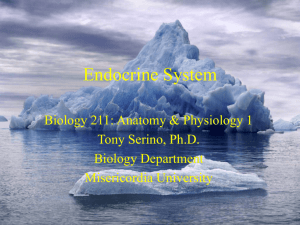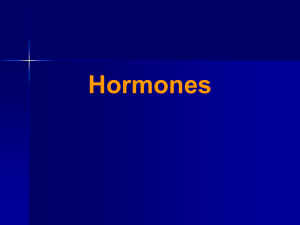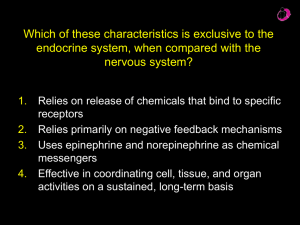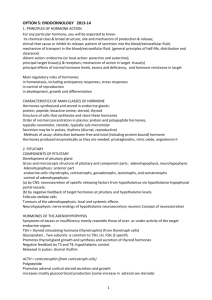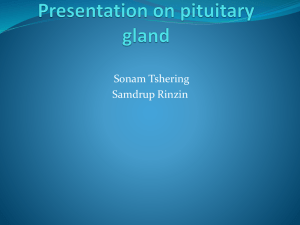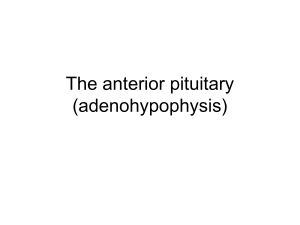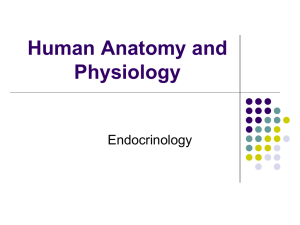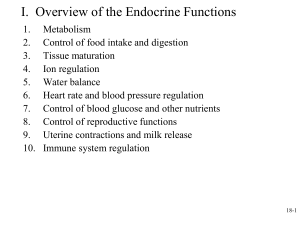The Endocrine System
advertisement
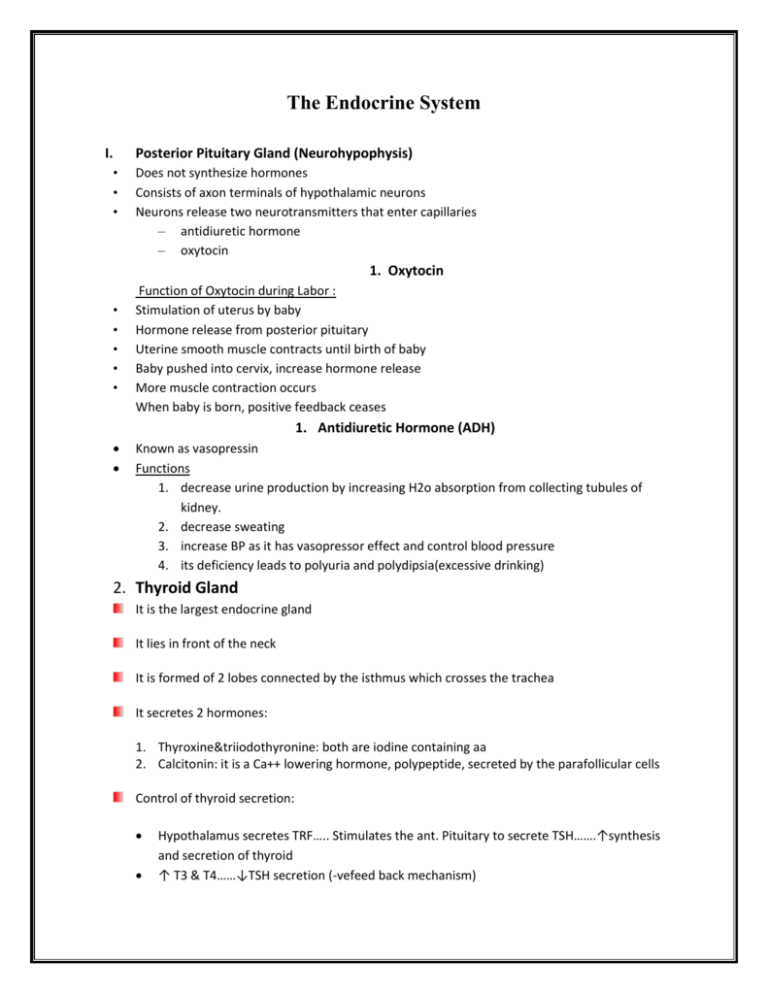
The Endocrine System I. • • • Posterior Pituitary Gland (Neurohypophysis) Does not synthesize hormones Consists of axon terminals of hypothalamic neurons Neurons release two neurotransmitters that enter capillaries – antidiuretic hormone – oxytocin 1. Oxytocin • • • • • Function of Oxytocin during Labor : Stimulation of uterus by baby Hormone release from posterior pituitary Uterine smooth muscle contracts until birth of baby Baby pushed into cervix, increase hormone release More muscle contraction occurs When baby is born, positive feedback ceases 1. Antidiuretic Hormone (ADH) Known as vasopressin Functions 1. decrease urine production by increasing H2o absorption from collecting tubules of kidney. 2. decrease sweating 3. increase BP as it has vasopressor effect and control blood pressure 4. its deficiency leads to polyuria and polydipsia(excessive drinking) 2. Thyroid Gland It is the largest endocrine gland It lies in front of the neck It is formed of 2 lobes connected by the isthmus which crosses the trachea It secretes 2 hormones: 1. Thyroxine&triiodothyronine: both are iodine containing aa 2. Calcitonin: it is a Ca++ lowering hormone, polypeptide, secreted by the parafollicular cells Control of thyroid secretion: Hypothalamus secretes TRF….. Stimulates the ant. Pituitary to secrete TSH…….↑synthesis and secretion of thyroid ↑ T3 & T4……↓TSH secretion (-vefeed back mechanism) ◦ ◦ ◦ ◦ Calcitonin – accelerates storage of calcium in bones and lowers blood calcium levels; 99% of calcium in the body is stored in bones, necessary for blood clotting, and holding cells together Decreases blood calcium levels by causing its deposition on bone Antagonistic to parathyroid hormone Produced by C (parafollicular) cells Action of thyroid T3 ND T4 hormones : 1. Increase oxygen consumption and enhance the metabolism of all body tissues, 2. On protein metabolism: they increase protein synthesis in muscles , liver and kidney .they stimulate growth. They increase activity of most enzymes in cells .In large doses they are catabolic. 3. On carbohydrates: they increase the rate of glucose absorption, uptake and utilization by tissues .glycogenolysis and gluconeogenesis are enhanced . 4. On fat: they increase the mobilization of fat from its stores and use its fat for production of energy e.g. lipolytic effect .it decreases level of plasma cholesterol . 5. On cardiovascular system they accelerate heart rate and force of contraction, increase systolic blood pressure and decrease diastolic blood pressure . 6. On G.I.T. :increase appetite ,mobility and secretion of G.I.T. 7. On C.N .S: they are important for normal development ,myelination and maturation of C.N .S. 8. On blood :increase erythropoiesis 9. Help development of skin ,hair,nails ,…. Hypo function: a) Before puberty:--cretinism .mental retardation , retarded growth ,intolerance of cold, muscle weakness(ABDOMINAL MUSCLE WEAKNESSPROTRUDED VISCERA),PROTURUDED ENLARED TONGUE, thick skin . infantile sexual organs, increase cholesterol b) After puberty-myxedema : slow mental activity, sensitive to cold ,firm non pitting oedema, hair is coarse and space, dry skin. sexual hypo function (female irregular menstrual cycle and male impotence), anaemia ,high cholesterol ,weakness and increase cholesterol. Hyper function: (Grave ,disease) 1. exophthalmos due to excessive degenerative tissues behind the eyes and weakness of extra ocular muscles 2. Goitre 3. Warm sweating palm due to V.D. 4. Rapid heart rate 5. Loss of weight 6. Fine tremors in hands and tongue 7. Intolerance of heat 8. Demineralization of bones with loss of calcium 9. General weakness 10. Insomnia ,diarrhoea 3. Parathyroid Glands • • • • Raise blood calcium levels – lose bone )(it causes resorption of Ca and P from bone) By increase activity of osteoclasts On intestine : it increases Ca and P absorption by increasing formation of 1,25,(H2o) vit.D3 which help absorption of Ca and Phosphate. On kidney : it increases reabsorption of Ca from renal tubules and increases P excretion Opposite function of calcitonin Control of parathyroid H.: 1. Negative feedback. If Ca ions increases in blood ,the secretion of H. decreases and visa versa. Abnormalities: 2. Deficiency :causestetany which is an increase neuromuscular excitability due to decrease ionized calcium in plasma. The normal level of plasma calcium is 9-11 mg % 3. Increase: increase Ca ion which -hypercalcemia .Ca and P may be deposited in kidney forming stones bone is affected and becomes decalcified and easily fractured. 4. Adrenal Glands 5. One on top of each kidney 6. 3 x 3 x 1 cm in size and weighs 5 grams 7. Cortex produces mineralocorticoids, glucocorticoids, and androgens 8. Medulla produces epinephrine & norepinephrine Mineralocorticoids • • • • Functions : Hormones that regulate mineral balance: increase reabsorption of Na+ with Cl- by renal tubules and water due to osmotic obligation decrease reabsorption of K ,Magnesium and hydrogen. Also, cause reabsorption of Na and Cl form G.I.T ,saliva and sweat and K secretion in them . • 95% of hormonal activity due to aldosterone ------Cortex – Glucocorticoids • Hormones that regulate glucose balance • 95% of hormonal activity is due to cortisol • Functions : help regulate metabolism – increase rate of protein (catabolic )and fat breakdown (lipolytic ); mobilize fat from fat depots and ketogenic. – provide resistance to stress by making nutrients available for ATP production – raise BP by vasoconstriction – anti-inflammatory effects reduced (as in skin cream).it decrease vascular permeability. – antiallergic action opposing the effect of histamine – decrease eosinophil count and lymphocytes but increase erythrocytes and neutrophils. – On C N S :give sense of well – Permissive role in all body function Control of cortical secretion 1. Hypothalamus :ACTRH increase secretion of ACTH 2. Anterior pituitary :ACTH increase its secretion 3. Physical and mental stress increase ACTRHincrease ACTHincrease its secretion ------Cortex – Androgens • Small amount of male hormone produced – insignificant in males – may contribute to sex drive in females – is converted to estrogen in postmenopausal females Abnormalities of adrenal cortex functions Hyper function: 1. Cushing syndrome: It is characterized by: a) Wasting and weakness of muscles (catabolic effect) b) Increase Na and water retention in blood oedema ,hypertension and decreas of blood K c) Hyperglycemia d) Redistribution of fat; thin extremities ,accumulation in abdominal wall,face (moon face ) andupper back (buffalo trunk ) e) Skin is thin and with striae f) Gonadal disturbances 2. Adreno-genital syndrome:. Due to excess sex hormons secondary to adrenal hyperfunction due to yumour of cortex precocious puberty in males and adrenal virilism, in females due to exess androgens. Hypo function: Addisons disease: due to adrenal cortex insufficiency It is characterized by: 1. Loss of appetite ,vomiting ,diarrhoea ile.GIT disturbances 2. Muscle weakness due to anabolic effect of androges 3. Decrease Na ,increase K in blood . water moves intracellularly—>decreas blood volume and hypotension and may be shock 4. Hypoglycaemia 5. Bronze hyperpigmentation of skin due to high level of ACTH secondary to low level of glucocorticoids.ACTH has melanocytic stimulating activity 6. Decrease sexual function D. Pancreatic Hormones • Endocrine cells in pancreatic islets produce hormones Cell Types in the Pancreatic Islets • Alpha cells (20%) produce glucagon • Beta cells (70%) produce insulin • 2 others Function of insulin: a) Increases glycogen deposition in liver and skeletal muscle b) Increases glucose uptake by tissues and its oxidation c) Inhibits gluconeogenesis and glycogenolysis d) Help protein deposition in cells e) Help fat formation help growth of tissues f) Introduces K intracellularly .thus decreases it in serum Diabetes Mellitus Due to failure of pancreas to secreate insulinincrease glucose in blood ,polyuria ,polydypesia and polyphagia . Function of glucogon Elevates blood glucose by increasing glycogeolysis and gluconeogenesis .also , increases heart rate and force of cardiac contraction Regulation of Glucagon & Insulin Secretion • Low blood glucose stimulates release of glucagon • High blood glucose stimulates secretion of insulin E. Ovaries and Testes 1. Ovaries a. estrogen, progesterone, relaxin&inhibin b. regulate reproductive cycle, maintain pregnancy & prepare mammary glands for lactation 2. Testes a. produce testosterone b. regulate sperm production & 2nd sexual characteristics
